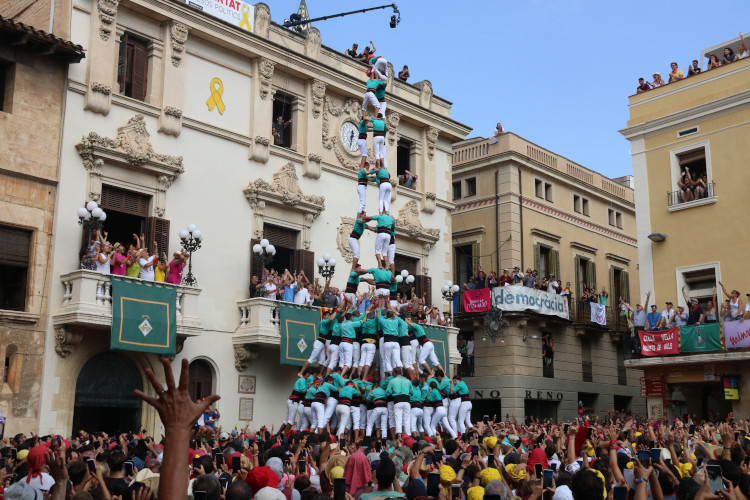Vilafranca 'castellers' create 10-tier human tower for first time since pandemic began
Biggest day in quintessential Catalan tradition for three years as groups steadily return to old shape

Vilafranca del Penedès' annual local Sant Fèlix celebration is every year one of the highlights of the castellers season and, after two editions with major Covid restrictions hampering it, the capital of the winegrowing Alt Penedès county witnessed again a bright day of human towers.
This quintessential Catalan tradition had boasted just a few ten-tier constructions since the first time this level was reached in 1998, but none after the pandemic began.
Yet, on Tuesday, the local biggest 'colla', or group, the Castellers de Vilafranca, managed to construct a ten-tier tower with three people in each, a 'tres de deu', for those into the jargon.
Participants fell upon deconstruction, but this did not prevent the joy of attendees.
Castellers are a Catalan tradition going back to the 18th century, with dozens of groups creating human towers across the country.
This year's Sant Fèlix was the most successful day in it since late 2019 as the four groups taking part are steadily returning to their old shapes.
Several maximum category towers
The ten-tier construction with two tiers of extra support to the base ('folre i manilles') was matched with another tower of similar difficulty, the two-people eight-tier one without any tier of extra support to the base, built – but also collapsing upon deconstruction – by the Colla Vella dels Xiquets de Valls, from western Catalan Valls.
Both Vilafranca and Valls are two of the main strongholds of the tradition in the whole of Catalonia.
The success of 2022 Sant Fèlix was also accompanied by three other 'gamma extra' (or 'maximum category') towers created by the Vilafranca team: the nine-tier construction with five people in each and with only one extra support to the base ('cinc de nou amb folre'), a similar one but with an extra tier of support and two people per tier ('dos de nou amb folre i manilles') and an eight-tier one with a single person in each and both 'folre and manilles' to support the base ('pilar de vuit amb folre i manilles').
The Colla Jove dels Xiquets de Valls, also coming from Valls, also took part in order to also create a 'pilar de vuit amb folre i manilles', as long as a 'cinc de nou amb folre', two first-class towers.
Meanwhile, the constructions of the Minyons de Terrassa, from the Barcelona metropolitan city of Terrassa, included a 'tres de nou amb folre', a 'quatre de nou amb folre' and a 'cinc de vuit', meaning two nine-tier and an eight-tier tower.
What are 'castells'?
Catalonia's 'castells' were declared an intangible heritage of humanity by UNESCO in 2010.
Large 'colles' form tiers of differing numbers of people standing on the shoulders of those below them.
Built to the sound of 'gralla' flutes and drums, human towers are only complete once a helmet-donning child called the 'enxaneta' ascends to the very top of the structure and raises their arm.
"Doing 'castells' has been a popular activity for more than 200 years and they are always associated with traditional celebrations such as ('festa major') village fairs," Ignasi Escamilla, of the Catalan human tower groups association, told Catalan News in June 2022.
According to Escamilla, however, 'castells' are more than just a thing of beauty: "They are a good example of an ideal society. It's the achievement of common goals obtained thanks to the cooperation of different team members."
Listen to our latest Filling the Sink podcast episode to learn more about 'Castells':